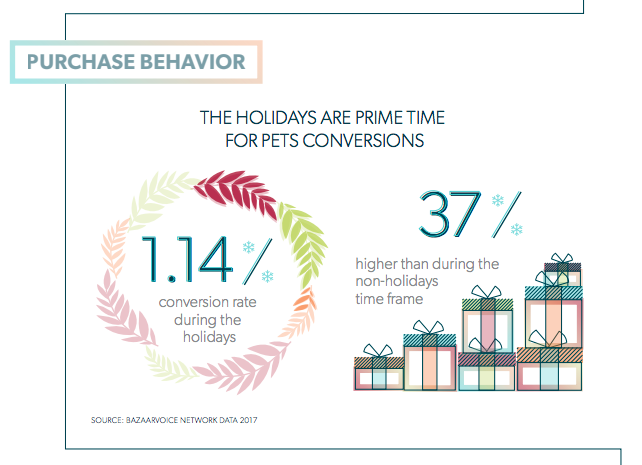December 8, 2017
Five years ago, I probably wouldn’t have been writing about how to target pet owners with advertising. But five years ago, Americans weren’t spending almost $70 billion a year on their animals.
As millennials grow up, they have waited longer than their parents to buy a house and have kids. At the age when baby boomers were getting married, we millennials are making a different kind of commitment — we’re getting pets. According to recent reports, millennials have become the primary pet-owning demographic in the United States.
This lifestyle change has had drastic impact on the retail industry. Spending on pets has continued to increase year over year, despite the recession and the retail apocalypse, and will only continue to do so. The U.S pet industry is expected to grow to $100 billion over the next three years.
In our own study of 2016 holiday shopping across 5,700+ brand and retailer sites in seven different product categories, the pet category saw online traffic increase by 30% and conversion increase by 37% from fall to winter. Pet parents are not forgetting their animals when it comes to holiday gift giving. Many American shoppers are buying gifts for their pets like they would for a child.
How can advertisers reach this pet-loving audience? The average pet parent will flow through four major stages on their way to becoming a forever customer. Here’s how you should adjust your online advertising tactics to reach pet shoppers at every stage of the consumer journey — and how you should be measuring success.

Awareness
Awareness of your brand is the cornerstone of marketing success. This means a consumer is exposed to your brand’s name and logo across different channels, sees your products in store, or hears about your brand from another pet parent at the dog park.
Pet products are a unique type of thing; it’s unlikely that you would buy pet stuff, or probably even browse online for it, unless you have a pet. Because of this, advertisers can’t use demographic or geographic ad targeting to reach pet owners. How can you reach pet owners to ensure your getting your brand out there? Base your advertising off of intent signals instead. For example, if your advertising data can show you who is engaging with product pages for pet products, this is a great sign that someone is a pet owner or at least in-market for pet items.
KPIs to consider: Delivery, click-through rate, video completion rate
Consideration
From there, the pet parent will move into the consideration stage: they want to buy a new toy for a Christmas gift, but which brand and product line? Remember, pet parents consider their animals to be part of the family. Every pet is special, with different dietary needs, restrictions, and preferences. This is where the deep research begins. In fact, we see that 70% of online shoppers in the pets category read reviews in purchasing.
Having a healthy and happy pet requires careful consideration, and most pet parents will trust their peers, especially because the effectiveness of a certain diet or pet product can only be evaluated after extended use. In this stage, make sure your advertising drives consumers to informative pages where they can learn more about your brand values, see detailed product information, read ratings and reviews from other trusted pet parents, and see endorsements from veterinarians.
KPIs to consider: “Learn More” page button clicks, time on site, visits, high value action/engagement rate
Buy
Driving a user to buy has a lot to do with timing, seasonality, and understanding the life cycle of your product. Ultimately, most pet parents will make purchases for their pet in-store while they pick up basics for the rest of the household. But that doesn’t mean they aren’t pulling up their phone in the aisle to compare prices or check product ratings and reviews. Through our ROBO study, we see that for every incremental $1 sold online in the pets category, an additional $3.87 is sold in-store as a result of reading a review. In pet campaigns we have run, we have seen huge correlations between shoppers who are in-market for bulk groceries and those who buy pet food online — makes sense, right?
In running an advertising campaign with an acquisition goal, you can drive your users to your online store, to a retailer site where your product is sold, or to a “where to buy” page as a proxy to conversion. If your advertising data can allow you to target shoppers who have shown multiple intent signals, this is the best way to reach pet owners who are ripe for conversion. A pet owner that has recently viewed multiple product pages across different retailers and looked at customer reviews and photos is likely getting ready to make a pet purchase.
Work with your advertising team or partner to determine these unique signals that show purchase intent. You should also use conversion data to continually learn and optimize throughout the campaign. You may also choose to work with an attribution vendor, who can demonstrate how your online advertising is impacting sales in store.
KPIs to consider: Return on advertising spend, sales, offline store visits
Repurchase
Finally, a time will come when the pet parent in question will need to refill their prescription, repurchase food and treats, or replace torn up toys and well-used accessories, and it’s always easier to keep a customer than win a new one. The best marketing tactic here is to convince the shopper to be a lifelong customer with the quality, value, and effectiveness of your product.
That being said, it never hurts to use advertising to entice continual repurchase. Consider featuring special prices in your ad creative, running co-branded campaigns with retailers, sending post-interactions emails after each purchase, or offering free shipping to returning customers.
To ensure your advertising in this stage is most effective, you need to be able to target known online past purchasers of your brand or product.
KPIs to consider: “Where to Buy” site traffic, sales data
All signs are pointing to a big holiday season (and 2018) for the pet industry. As spending increases, so does competition and noise. Brands in the pet space can find, reach, and win in-market pet shoppers by adjusting their advertising strategy for every stage of the consumer decision journey.
For more insights and trends for the holiday shopping season, including a pet-specific infographic, visit our Holiday Headquarters.





